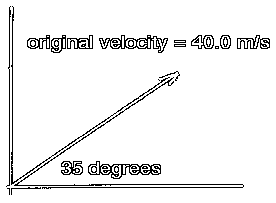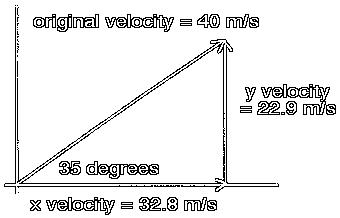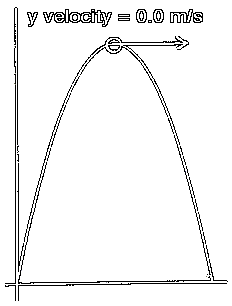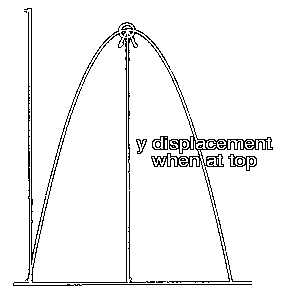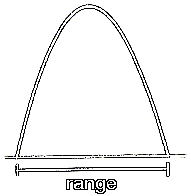EQUILIBRIUM
- Always set positive axes so that negative numbers won't appear in the solution.
- There is no acceleration in both x and y because there is no movement in either of the component.
- There must be no friction because friction on the string or whatever is connecting the two masses can result in inequality between two values on the same axis. (The components should be in balance in equilibrium questions.)
Assumptions
- a = 0
- no friction
F = ma
Fₓ = ma Fy = ma
T1ₓ - T2ₓ = 0 -Fg + T1y + T2y = 0
T1ₓ = T2ₓ T1y + T2y = Fg
T1sinB + T2sinA = mg
(T1sinB + T2sinA) / g = m
INCLINES
Static - the object on the inclined plane is not moving yet, hence no value for acceleration.
Assumptions
- fs = µFn
- a = 0
- +ve axes in the direction of decline
- no air resistance
Fy = ma
Fy = 0
Fn - Fgy = 0
Fn = Fgy
Fn = Fgcosθ
Fₓ = ma
Fₓ = 0
-f + Fgₓ = 0
Fgₓ = f
Fgsinθ = µFn
Fgsinθ = µFn
Fgsinθ = µFgcosθ
sinθ = µcosθ
sinθ / cosθ = µ
tanθ = µ
Kinetic - the object is moving, hence value for acceleration on only the x-axis (not on y-axis because the object is not jumping up and down)
Assumptions
- fk = µkFn
- aₓ ≠ 0, ay = 0
- +ve in the direction of a
- no air resistance
a = ?
Fy = ma
Fy = 0
Fn - Fgy = 0
Fn = Fgy
Fn = Fgcos
θ
Fn = mgcosθ
Fₓ = maₓ
Fgₓ - f = maₓ
Fgsinθ - µFn = maₓ
mgsinθ - µmgcosθ = maₓ
(mgsinθ - µmgcosθ) / m = aₓ
PULLEYS
- For pulleys, you MUST remember to draw two free-body diagrams that have different positive axes.
- You can just use T for tension because the tensions present are equal.
- In pulleys, there is no force that is working horizontally, thus no Fₓ (except when the problem deals with one mass on a horizontal surface)
Assumptions
- frictionless pulleys + rope
- no air resistance
- multiple FBDs
- +ve in the direction of a
- T1 = T2
- a of the system is the same
m1
F = ma
Fₓ = ma
Fₓ = 0
(cancel out)
Fy = m1ay
m1g - T = m1a
m2
F = ma
Fₓ = ma
Fₓ = 0
(cancel out)
Fy = m2ay
T - m2g = m2ay
Find a
m1g - T = m1a 1
T - m2g = m2a 2
From 1 T = m1g - m1a 3
From 2 T = m2a + m2g 4
Set 3 = 4 m1g - m1a = m2a + m2g
collect the like terms m1g - m2g = m2a + m1a
factor out a m1g - m2g = a (m2 + m1)
(m1g - m2g) / (m2 + m1) = a
Find T
use one of the equation used in the above part
T = m1g - m1a
substitute a with the value that you get
T = ( )N
TRAINS
- Simply put, trains are like pulleys put horizontally.
- The pulling force of the foremost mass is the engine which is represented by Fₐ. The pulling force of the following masses are the according tensions.
- For trains, you MUST remember to draw 3 FBDs.
- The value of the vertical acceleration is zero because the train is not jumping up and down.
Assumptions
- 1 FBD for a
- 3 FBDs for T1 and T2
- ay = 0
- a is consistent
- no air resistance
- weightless cables
- +ve in the direction of a
After having drawn the free-body diagrams for each body of the train, you must combine everything so that the whole train becomes a little dot on your free-body diagram. This diagram you draw will be the FBD for the acceleration.
F = ma
Fₓ = maₓ
Fₐ - f = maₓ
Fₐ - µmg = maₓ
(Fₐ - µmg) / m = aₓ
Fy = may
Fy = 0
Fn - mg = 0
Fn = mg
m1
F = ma
Fy = m1ay
Fn1 - m1g = 0
Fn1 = m1g
Fₓ = m1aₓ
Fₐ - T1 - f1 = m1aₓ
Fₐ - T1 - µm1g = m1aₓ
Fₐ - µmg - m1aₓ = T1
m3
(instead of using m2 to find T2, which is perfectly fine, it's better to use m3 because using m3 increases the chance of you getting the correct answer due to the fact that there is one less variable)
F = ma
Fy = m3ay
Fy = 0
Fn3 - m3g = 0
Fn3 = m3g
Fₓ = m3aₓ
T2 - f3 = m3aₓ
T2 = m3aₓ + f3
T2 = m3aₓ + µm3g
SUMMARY OF THE ASSUMPTIONS FOR EACH TYPE OF QUESTION
EQUILIBRIUM
- no friction
- a = 0 (for both x and y)
INCLINES (STATIC)
- fs = µsFn
- a = 0 (for both x and y)
- +ve in direction of a
- no air resistance
- µ = tanθ
INCLINES (KINETIC)
- fk = µkFn
- Fn  to surface
to surface - aₓ ≠ 0, ay = 0
- +ve in direction of a
- no air resistance
PULLEY
- frictionless pulleys + rope
- no air resistance
- multiple FBDs
- +ve in direction of a
- T1 = T2; therefore, you can just call them 'T'
- a1 = a2
TRAIN
- 1 FBD for a (the big one)
- 3 FBDs for T1 and T2 (one per mass)
- ay = 0
- a is consistent
- no air resistance
- weightless cables
- +ve in direction of a







 to surface
to surface